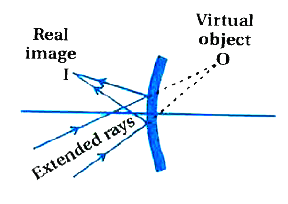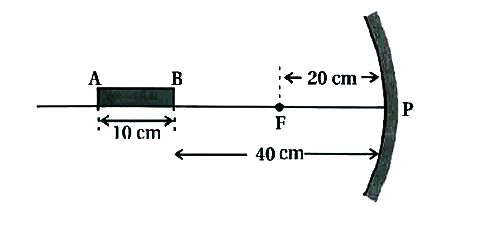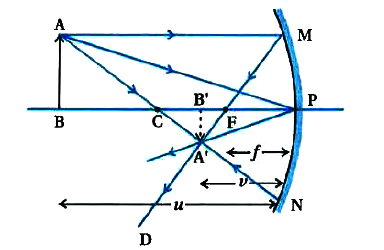Answer the following questions:
(b) A virtual image, we always say, cannot be caught on a screen. Yet when we 'see' a virtual image, we are obviously bringing it on to the 'screen' (i.e., the retina) of our eye. Is there a contradiction? Solution in Gujrati
When reflected and refrcered rays move away from each other, than the image will be virtual. They can be converged to screen by proper lens. The convex lens of eye does the same. Here, virtual image works as object for· lens, hence gives real image. Note thaL here screen is not at the place of virtual image. There is no contradiction.

Topper's Solved these Questions
- RAY OPTICS AND OPTICAL INSTRUMENTSBOOK - KUMAR PRAKASHANCHAPTER - RAY OPTICS AND OPTICAL INSTRUMENTSEXERCISE - SECTION-B (NUMERICALS)(NUMERICAL FROM .DARPAN. BASED ON TEXTBOOK )
12 Videos
- RAY OPTICS AND OPTICAL INSTRUMENTSBOOK - KUMAR PRAKASHANCHAPTER - RAY OPTICS AND OPTICAL INSTRUMENTSEXERCISE - SECTION-C (NCERT EXEMPLAR SOLUTION) (MULTIPLE CHOICE QUESTIONS (MCQs))
16 Videos
- RAY OPTICS AND OPTICAL INSTRUMENTSBOOK - KUMAR PRAKASHANCHAPTER - RAY OPTICS AND OPTICAL INSTRUMENTSEXERCISE - SECTION-B (NUMERICALS)(NUMERICAL FROM TEXTUAL ILLUSTRATIONS)
17 Videos
- MOVING CHARGES AND MAGNETISMBOOK - KUMAR PRAKASHANCHAPTER - MOVING CHARGES AND MAGNETISMEXERCISE - SECTION D (MCQs ASKED IN COMPETITIVE EXAMS)
34 Videos
- SAMPLE QUESTION PAPER BOOK - KUMAR PRAKASHANCHAPTER - SAMPLE QUESTION PAPER EXERCISE - PART-B SECTION-C
5 Videos
Similar Questions
As shown in the figure, a thin rod AB of length 10 cm is placed on the principal axis of a concave mirror such that it.s end B is at a distance of 40 cm from the mirror. If the focal length of the mirror is 20 cm, find the length of the image of the rod

View SolutionA ray of light incident at an angle θ on a refracting face of a prism emerges from the other face normally. If the angle of the prism is 5∘ and the prism is made of a material of refractive index 1.5, the angle of incidence is
View SolutionSuppose that the lower half of the concave mirror.s reflecting surface as shown in figure is covered with an opaque (non-reflective) material. What effect will this have on the image of an object placed in front of the mirror ?

View SolutionElectric charge Q having mass M moves on a circular path of radius R with velocity →v, perpendicular to uniform magnetic field B. When a particle completes one revolution, work done by the field is _______
View SolutionTwo charges –q and +q are located at points (0, 0, –a) and (0, 0, a), respectively.
(a) What is the electrostatic potential at the points (0, 0, z) and (x, y, 0) ?
(b) Obtain the dependence of potential on the distance r of a point from the origin when r/a>>1 .
(c) How much work is done in moving a small test charge from the point (5,0,0) to (–7,0,0) along the x-axis? Does the answer change if the path of the test charge between the same points is not along the x-axis?
View SolutionHow can we see a virtual image when it cannot be obtained on a screen ?
View Solutionनिम्नलिखित प्रश्नो के उत्तर लिखिए-
(a) आपने सीखा है कि समतल तथा उत्तल दर्पण सदैव आभासी प्रतिबिम्ब बनाते है| क्या ये दर्पण किन्हीं परिस्थितियों में वास्तविक प्रतिबिम्ब बना सकते है? स्पष्ट कीजिए |
(b) हम सदैव कहते है कि आभासी प्रतिबिम्ब को परदे पर केन्द्रित नहीं किया जा सकता | यधपि जब हम किसी आभासी प्रतिबिम्ब को कहते है तो हम इसे स्वाभाविक रूप में अपनी आँख कि स्क्रीन (अर्थात रेटिना)पर लाते है| क्या इसमें कोई विरोधाभास है?
(c ) किसी झील के तट पर खड़ा मछुआरा झील के भीतर किसी गोताखार द्वारा तिरछा देखने पर अपनी वास्तविक लम्बाई की तुलना में कैसा प्रतीत होगा-छोटा अथवा लम्बा ?
(d) क्या तिरछा देखने पर किसी जल के टैंक की आभासी गहराई परिवर्तित हो जाती है ? यदि हाँ, तो आभासी गहराई घटती है अथवा बढ़ जाती है?
(e ) सामान्य काँच की तुलना में हीरे का अपवर्तनांक काफी अधिक होता है ? क्या हीरे को तराशने वालों के लिए इस तथ्य का कोई उपयोग होता है?
View Solutionहम सदैव कहते हैं कि आभासी प्रतिबिम्ब को परदे पर केन्द्रित नहीं किया जा सकता। यद्यपि जब हम किसी आभासी प्रतिबिम्ब को देखते हैं तो हम इसे स्वाभाविक रूप में अपनी आँख की स्क्रीन (अर्थात् रेटिना) पर लाते हैं। क्या इसमें कोई विरोधाभास है ?
View Solutionb) A virtual image, we always say, can-not be caught on a screen. Yet when we 'see' a virtual image, we are obviously bringing it on to the 'screen' (i.e., the retina) of our eye. Is there a contradication ?
View SolutionA virtual cannot be caought on a screen, Yet when we see a virtual image, we bring it to the screen i.e., retina of our eye. This happnes because
View SolutionA virtual cannot be caought on a screen, Yet when we see a virtual image, we bring it to the screen i.e., retina of our eye. This happnes because
View SolutionAnswer the following questions:
(b) A virtual image, we always say, cannot be caught on a screen. Yet when we 'see' a virtual image, we are obviously bringing it on to the 'screen' (i.e., the retina) of our eye. Is there a contradiction?
View SolutionA virtual image. We always say, cannot be caught on a screen. Yet when we 'see' a virtual image, we are obviously bringing it on to the 'screen ' (i.e., the retina ) of our eye. Is there a contradiction ?
View SolutionAnswer the following questions:
(b) A virtual image, we always say, cannot be caught on a screen. Yet when we 'see' a virtual image, we are obviously bringing it on to the 'screen' (i.e., the retina) of our eye. Is there a contradiction?
View SolutionAnswer the following questions:
(b) A virtual image, we always say, cannot be caught on a screen. Yet when we 'see' a virtual image, we are obviously bringing it on to the 'screen' (i.e., the retina) of our eye. Is there a contradiction?
View SolutionAnswer the following questions:
(b) A virtual image, we always say, cannot be caught on a screen. Yet when we 'see' a virtual image, we are obviously bringing it on to the 'screen' (i.e., the retina) of our eye. Is there a contradiction?
View Solution
